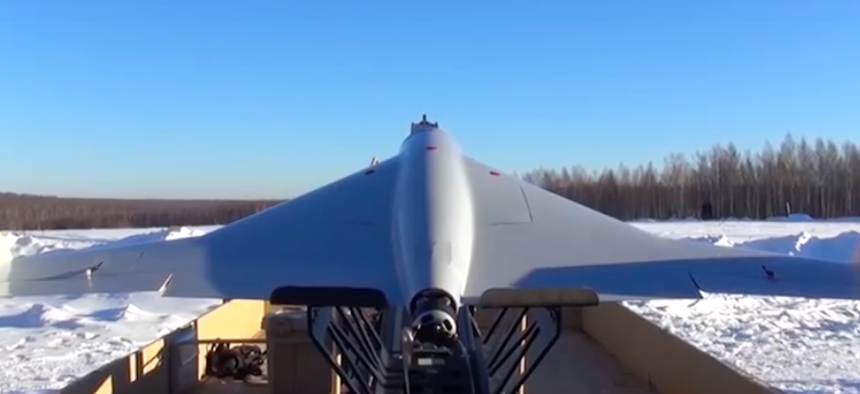
Zala Aero Group via Youtube
Will Kalashnikov's New Drone Be the AK-47 of Indirect Fire?
The company that made assault rifles ubiquitous says its KUB can put a warhead on a miles-distant target.
Cheap and rugged, the Kalashnikov AK-47 made assault rifles ubiquitous in the world’s trouble spots. Now the famed Russian weapons designer is offering a smallish drone that it says can crash its 3-kilogram warhead into a target more than 40 kilometers away. If the new drone is anything like the AK-47, it heralds the dawn of a new era of warfare with global ramifications.
Company officials, who displayed a half-scale model of the KUB at February’s IDEX 2019 arms show in Abu Dhabi, said the 1.2-meter drone can fly for 30 minutes at “80 to 130 kilometers per hour.” “It is [an] extremely accurate and efficient weapon,” Sergey Chemezov, CEO of Kalashnikov’s corporate parent Rostec, said in a Feb. 17 statement, adding that it is “very hard to combat by traditional air defense systems.”
To be sure, the United States fields its own “suicide drones.” U.S. special operations soldiers used them to go after ISIS members during the 2016-17 battle to take back Mosul.
But this is different. The Kalashnikov Group is best known for its AK-47, a 1949 design that remains the most widely used assault rifle on the planet. It’s a highly reliable weapon, it fuels insurgencies, it’s the terrorist weapon of choice, and it has been put to use on every geographic corner of the world. That same company now is offering for sale killer drones that promise to be low-cost, highly efficient, and able to evade aerial defenses.
Related: This Stealthy Drone May Be The Future of Russian Fighter Jets
Related: Russia Has Started to Train Its Entire Military to Fight Drones
Related: The Designer of Russia’s First Armed Drone Is Under Arrest
Our government is cautious (perhaps overly so) about allowing the export of military technology. We go to great lengths to ensure our drone technology doesn’t fall into the wrong hands. When we see commercial manufacturers creating drones that could be weaponized by civilians, we rush to ensure they are not allowed to do harm. The Russians don’t follow these rules.
Kalashnikov is already seeking wide sales of these devices. Many people will want them and you can bet that they bring with it the mass production, mass marketing, and mass adoption that any large-scale global business employs to ensure their devices obtain widespread adoption. It would not surprise me if we saw them appear in Maduro’s Venezuela, Assad’s Syria, and Kim’s North Korea — all regimes that Russia covertly supports.
It doesn’t take much imagination to foresee how such weapons might be used. Places like Mogadishu, where AK-47s are so ubiquitous that women and children carry them while walking down the street while warlords hawk them in the same markets where people buy groceries. No longer would groups like al-Shabaab need to sneak a suicide bomber through a checkpoint, when the new suicide bomber comes fast and from the sky. Infantry solders on the ground clearing villages in terrorist safe havens like Syria will no longer have to worry simply about what’s in front of them, but now what could come from above. Traditional aerial defenses are simply not designed to combat a swarm of these type of remote aircraft. Tactics will have to be rethought for this new generation of warfare, and billions of dollars spent on asymmetric defenses.
What if the next attempted assassination of a government leader succeeds because armed drones from a major manufacturer is able to make them virtually foolproof?
One thing is for sure, it’s time we invested heavily in counter-drone technology. We have the talent and the private sector is working hard to combat future drone threats with technology that exists today. Counter drone start-ups such as WhiteFox Defense, based in California, has built a system that can hijack a drone mid-flight and developed mobile, handheld systems that create geofences around individuals by forcing any drones entering a certain area to be detected and mitigated before they release a payload. Other companies like Echodyne, have developed long range radar systems that track unauthorized drones flying through restricted airspace.
But industry experts also know there is no one-size-fits-all solution yet. Drone technology is developing at such a rapid pace that going forward there will be a constant tug of war between the counter-drone industry and drone manufacturers wanting to get more aircraft in the sky.
With organizations like Kalashnikov now getting into the game of drones, there is no doubt that senior U.S. leaders will one day have to face the reality that technology once reserved only for elite militaries may wind up in the hands of unrestrained madmen.
NEXT STORY: Ep. 41: Climate Change vs. the US Military



